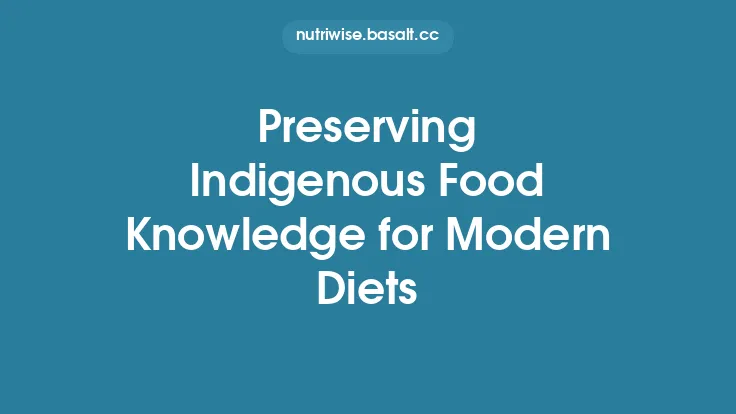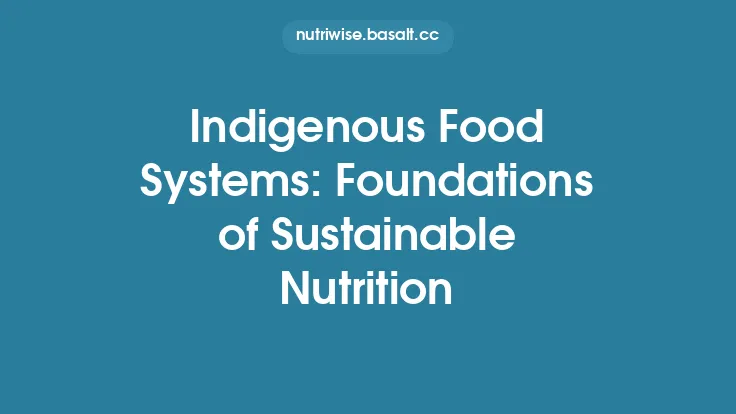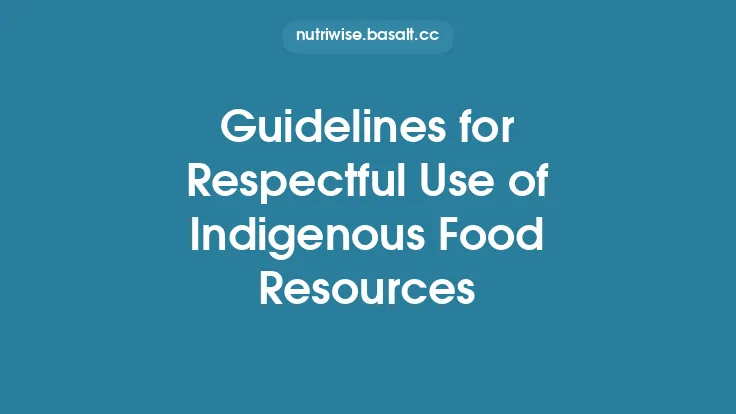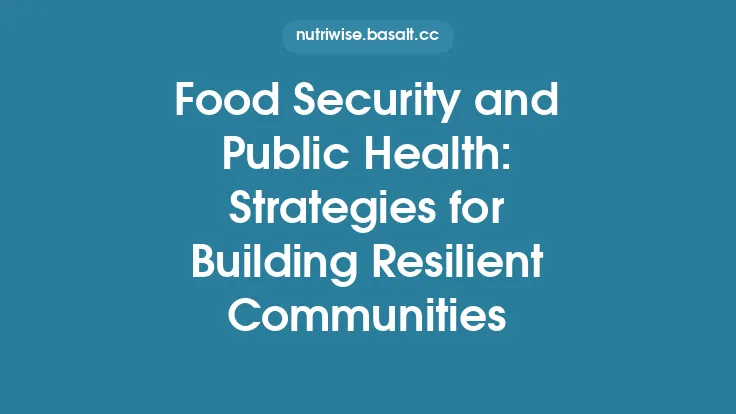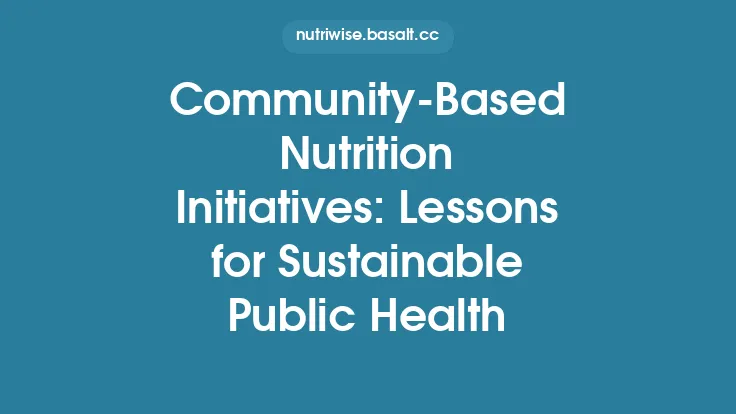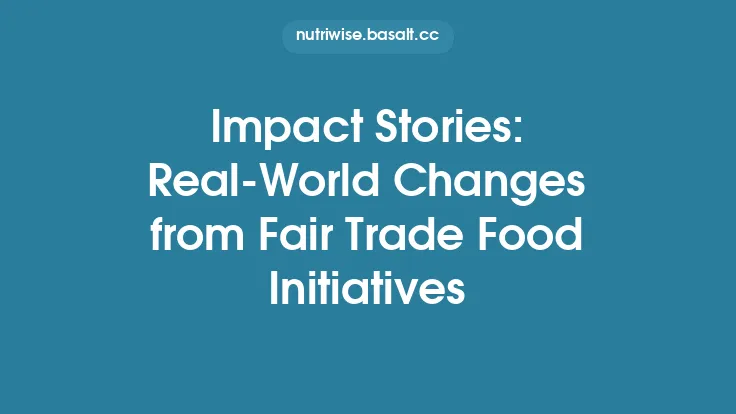Indigenous food sovereignty is more than a buzzword; it is a comprehensive framework that places Indigenous peoples at the helm of decisions affecting their food systems, health, and cultural continuity. By reclaiming control over the production, distribution, and consumption of food, communities can address historical injustices, improve nutritional outcomes, and strengthen social cohesion. This article explores the multifaceted dimensions of Indigenous food sovereignty, the mechanisms that enable it, and the tangible health benefits that arise when communities are empowered to shape their own food futures.
Defining Food Sovereignty in an Indigenous Context
Food sovereignty, as originally articulated by the international movement La Vía Campesina, emphasizes the right of peoples to define their own food and agriculture systems. When applied to Indigenous contexts, the concept expands to incorporate:
- Self‑determination: The political and cultural right to make autonomous decisions about land use, resource management, and food production.
- Cultural integrity: The preservation and revitalization of traditional food practices, ceremonies, and knowledge systems that are inseparable from identity.
- Land and water rights: Legal and practical control over territories and water sources that sustain food production.
- Economic autonomy: The ability to generate income and wealth through locally controlled food enterprises, reducing dependence on external markets.
These pillars intersect to create a holistic approach that links food security (the availability of sufficient food) with food sovereignty (the power to shape the food system).
Historical Disruptions and Their Health Implications
Colonial policies—such as forced relocation, the imposition of residential schools, and the suppression of traditional hunting, fishing, and gathering—have fragmented Indigenous food systems. The resulting loss of access to traditional foods has been linked to a cascade of health challenges:
- Increased prevalence of diet‑related chronic diseases (type 2 diabetes, cardiovascular disease) due to reliance on processed, low‑nutrient foods.
- Nutritional deficiencies stemming from limited diversity in purchased foods.
- Mental health stressors associated with cultural disconnection and loss of traditional knowledge.
Understanding these historical roots is essential for framing food sovereignty as a reparative and health‑promoting strategy rather than a mere nutritional intervention.
Governance Structures that Enable Sovereignty
Effective food sovereignty rests on robust governance mechanisms that reflect Indigenous values and decision‑making processes. Key structures include:
- Community Food Councils – Representative bodies that bring together elders, youth, hunters, fishers, farmers, and health professionals to set priorities, allocate resources, and monitor outcomes.
- Traditional Ecological Knowledge (TEK) Integration – Formal mechanisms for embedding TEK into land‑use planning, harvest protocols, and climate adaptation strategies.
- Co‑management Agreements – Partnerships with federal, provincial, or state agencies that recognize Indigenous jurisdiction over specific resources while providing technical support.
- Legal Frameworks – Utilization of treaties, land‑claim settlements, and Indigenous self‑government statutes to secure rights over food‑related territories.
These governance models foster accountability, transparency, and cultural relevance, ensuring that food initiatives align with community aspirations.
Economic Pathways: From Subsistence to Market Participation
While subsistence activities remain central, many Indigenous communities are diversifying their economies through food‑related enterprises that reinforce sovereignty:
- Community‑owned farms and orchards that employ local labor, retain profits within the community, and provide fresh produce for schools and health centers.
- Artisanal processing facilities (e.g., smoked fish, dried berries) that add value to traditional harvests and open niche market opportunities.
- Food cooperatives that aggregate products from multiple families or villages, enabling bulk purchasing power and collective branding.
- Eco‑tourism and culinary experiences that showcase Indigenous foodways to visitors, generating revenue while educating the broader public.
These ventures not only improve household incomes but also create feedback loops that reinforce cultural practices and health outcomes.
Health Outcomes Linked to Food Sovereignty
When Indigenous communities regain control over their food systems, measurable health improvements emerge across several dimensions:
- Nutritional status: Increased consumption of traditional foods—rich in micronutrients, omega‑3 fatty acids, and fiber—correlates with lower rates of obesity and metabolic syndrome.
- Mental and emotional well‑being: Participation in harvests, cooking, and communal meals strengthens cultural identity, reduces stress, and mitigates depression.
- Intergenerational health: Children who learn traditional food preparation develop healthier eating habits and a stronger sense of belonging, which translates into better academic performance and reduced risky behaviors.
- Resilience to food insecurity: Local food production buffers communities against market volatility, price spikes, and supply chain disruptions, ensuring a more stable food supply.
Longitudinal studies in several Indigenous nations have documented reductions in diabetes incidence and improvements in blood pressure control following the implementation of community‑led food sovereignty programs.
Case Studies Illustrating Empowerment in Action
1. The Anishinaabe Food Sovereignty Initiative (Northern Ontario)
- Approach: Established a community food council that negotiated co‑management of lake fisheries, restored traditional salmon runs, and created a fish processing hub owned by the band.
- Outcomes: Salmon harvests increased by 45 % within five years; local consumption of fish rose from 10 % to 68 % of household diets; reported hypertension rates declined by 12 % among adults.
2. Māori Whānau Gardens (Aotearoa New Zealand)
- Approach: Developed a network of family‑run gardens on reclaimed tribal lands, integrating mātauranga Māori (knowledge) into planting calendars and pest management.
- Outcomes: Garden participation grew from 15 families to over 200 within three years; school lunch programs incorporated 30 % more locally grown vegetables; community surveys indicated a 30 % increase in cultural pride.
3. Navajo Community Seed Bank (Southwest United States)
- Approach: Created a seed bank managed by a coalition of elders and youth, focusing on heirloom varieties adapted to arid conditions; linked seed distribution to a cooperative that sells value‑added products.
- Outcomes: Seed diversity increased by 22 % over six years; farm income rose by 18 % on average; participants reported improved food security during drought periods.
These examples demonstrate how governance, economic innovation, and cultural revitalization converge to produce tangible health benefits.
Overcoming Barriers to Food Sovereignty
Despite successes, many communities encounter obstacles that require strategic responses:
| Barrier | Strategies |
|---|---|
| Legal restrictions on land access | Pursue land‑claim settlements, negotiate co‑management agreements, and leverage Indigenous title claims. |
| Limited capital for infrastructure | Access to community‑directed financing (e.g., Indigenous Development Funds), crowd‑sourced capital, and partnerships with ethical investors. |
| Knowledge gaps among youth | Implement intergenerational mentorship programs, integrate food sovereignty into school curricula, and use digital platforms for TEK documentation. |
| Climate change impacts | Adopt climate‑smart practices rooted in TEK, diversify crop and species portfolios, and develop early‑warning systems for harvest timing. |
| Market competition from industrial agriculture | Emphasize niche branding (e.g., “Indigenous‑grown”), certify products through community‑based standards, and build direct‑to‑consumer channels. |
Addressing these challenges requires coordinated action across community, governmental, and non‑governmental sectors.
Policy Recommendations for Supporting Indigenous Food Sovereignty
To scale the health benefits of food sovereignty, policymakers at all levels can adopt the following measures:
- Recognize and enforce Indigenous land and water rights – Legal certainty is the foundation for any food system initiative.
- Allocate dedicated funding streams – Grants and loans specifically earmarked for Indigenous food enterprises, infrastructure, and capacity building.
- Integrate TEK into national agricultural and health policies – Ensure that Indigenous knowledge informs climate adaptation, nutrition guidelines, and public health planning.
- Facilitate cross‑jurisdictional collaboration – Create platforms where Indigenous governments, federal agencies, and NGOs can co‑design programs.
- Support data sovereignty – Enable communities to collect, own, and analyze health and food system data, preserving privacy and cultural integrity.
These policies not only empower communities but also contribute to broader goals of sustainability, biodiversity conservation, and public health resilience.
The Future of Indigenous Food Sovereignty and Community Health
Looking ahead, several emerging trends promise to deepen the impact of food sovereignty on health:
- Digital platforms for TEK exchange – Mobile apps and online repositories that allow elders to share harvest calendars, preparation methods, and medicinal uses with younger generations.
- Community‑driven research partnerships – Collaborative studies that place Indigenous researchers at the lead, ensuring that findings are relevant and actionable.
- Regenerative land‑care practices – Integration of fire stewardship, agroforestry, and soil carbon sequestration techniques that enhance ecosystem health and food productivity.
- Holistic health monitoring – Combining biomedical indicators with cultural wellness metrics (e.g., participation in ceremonies, language use) to capture the full spectrum of health outcomes.
By weaving together cultural revitalization, economic empowerment, and evidence‑based health strategies, Indigenous food sovereignty stands as a powerful lever for improving community health now and for generations to come.
